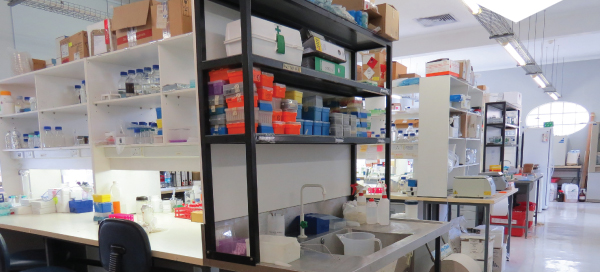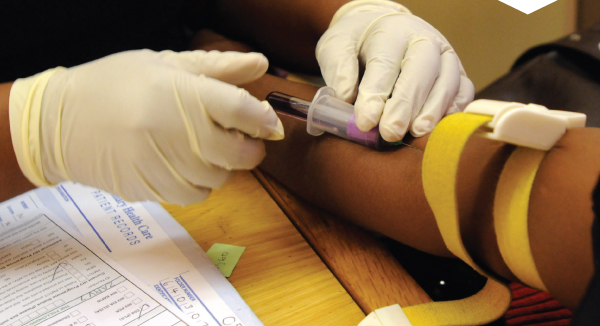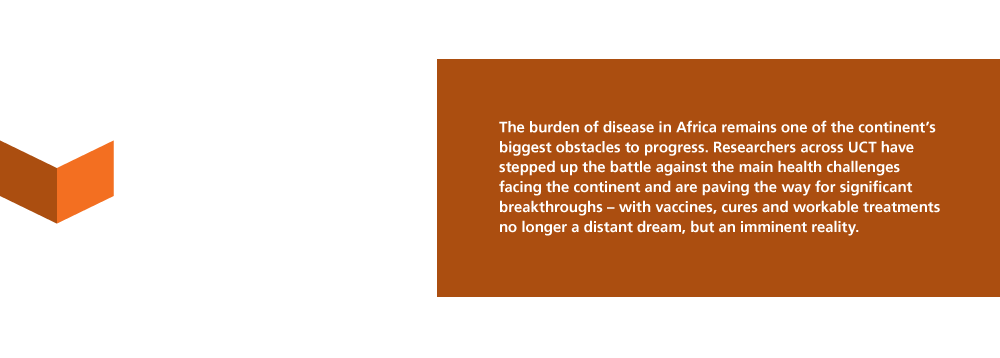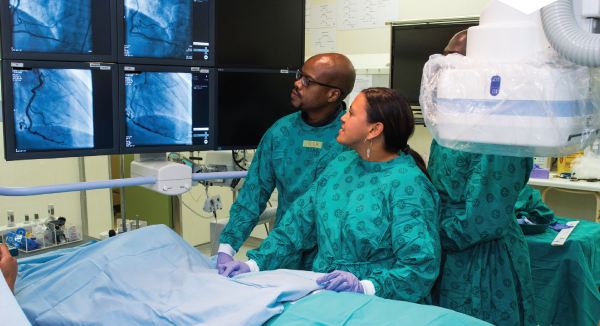Paving the way for a healthier continent
In its 2014 bulletin on world health statistics, the World Health Organisation (WHO) reports that the average life expectancy in sub-Saharan Africa for men and women is still below 55, despite global trends towards living longer. The risk of a child dying before its fifth birthday is eight times higher in the WHO Africa Region than in the WHO European Region.
The statistics point relentlessly to the fact that Africa’s development remains severely hampered by disease. Sub-Saharan Africa is the region worst affected by HIV/AIDS. South Africa has the highest prevalence of the disease in the world: about 5.6 million people are currently living with HIV in South Africa.
The country also has one of the most serious tuberculosis (TB) epidemics in the world, coupled with a rising number of TB cases as a result of HIV and TB co-infection. TB is now the leading cause of death in South Africa and, according to some estimates, about 80% of the population has latent TB. Other serious infectious diseases include malaria, which kills two children every minute in Africa.
Non-communicable diseases (NCDs) are also on the rise. Heart disease, stroke, diabetes and some cancers currently contribute to 30% of deaths in South Africa. About 6.3 million South Africans have high blood pressure and three million have type 2 diabetes. In addition, wider access to antiretroviral therapy has transformed HIV/AIDS into a chronic disease, meaning people are living long enough to be at risk from NCDs.
at the vanguard
Keenly aware of these statistics, the Faculty of Health Sciences is at the vanguard of the fight to contain the impact of disease on the continent. One of the largest and most prolific health faculties in Africa, it celebrated its 100th anniversary in 2012 and is moving into the next 100 years with some of the world’s top research groupings poised to make a tangible difference to the health of millions of Africans.
It is also one of the most well-resourced faculties in the developing world, attracting significant investment in its research. A highlight in 2013 was the fact that UCT drew more funding for direct grants from the prestigious National Institutes of Health (NIH) in the USA than any other non-American university in that year (see more).
The NIH is the largest source of medical funding in the world. When asked at a recent international press conference why so many principal investigators in the projects it was funding were from South Africa, the answer, they said, was scientific quality.
The faculty is “the crown jewel of medical schools in South Africa”, says its dean, Professor Wim de Villiers, who is proud of its place among the top medical schools in the world.
Interdisciplinary strength
One of the strengths of the faculty is the ability of its researchers to work together across various platforms in multidisciplinary collaborations to achieve extraordinary results, says Professor Bongani Mayosi. He is head of the Department of Medicine, the largest department in the faculty, which plays a leading role in medical education and research, as well as providing clinical services to the communities of the Western Cape.

“There are many examples of leading research in which we have made major discoveries that have deepened our understanding of biology based on the definition of new mechanisms of disease. We are also making an impact on the practice of medicine through the discovery of new diseases, and new ways of diagnosis and treatment of old diseases,” says Professor Mayosi.
The Institute of Infectious Disease and Molecular Medicine (IDM) exemplifies the interdisciplinary nature of the work in the faculty. “We have a critical mass at UCT: a large number of people working at the intersection of the basic, clinical and public health sciences. We are developing a culture of working together instead of in silos,” says Professor Valerie Mizrahi, who heads up the institute.
The IDM celebrates its 10th year in 2014 and has become a hub for interdisciplinary collaboration. Almost a fifth of the university’s research income is raised by members of the IDM, who are drawn from several departments in the Faculty of Health Sciences and the Faculty of Science.
Working at the cutting edge
When talking about the burden of disease, Professor Mizrahi says, “It’s not a pretty picture. The urgency of the medical need makes it essential to research new interventions and to learn as much as we can in the process.”
The IDM has become known as a leader in the areas of HIV/AIDS, TB, TB-HIV, human papilloma virus and parasitic disease research, with more than 20 research groupings, many of which have built a world-class reputation for their work in novel and innovative strategies to address disease in Africa.
One such group, the H3-D Drug Discovery and Development Centre, which is led by Professor Kelly Chibale from the Department of Chemistry in the Faculty of Science, is Africa’s first integrated modern drug discovery and development centre whose objective is to deliver drug candidates for clinical development. In 2013, the centre completed a study that is set to find a novel, pre-clinical drug candidate for malaria. The same year, H3-D also received a major boost from Celgene Global Health (CGH), a division of Celgene Corporation, a global biopharmaceutical company, to help identify novel drugs for the treatment of TB. Under the collaborative agreement, Celgene will provide H3-D with compounds that target TB, and H3-D scientists will optimise these compounds to deliver pre-clinical candidates suitable for testing in humans.
H3-D will also benefit from a new R370 million biotechnology partnership between UCT and the South African Medical Research Council (MRC) with funding and support from the Bill and Melinda Gates Foundation, the Department of Science and Technology and the Department of Health. The partnership’s purpose is to develop new medicines, vaccines and other biotechnologies to combat Africa’s big killers: HIV/AIDS, TB and malaria.
TB: a perfect storm
Of the three, the disease that is the closest to home is TB. “There is more TB in Cape Town than in Canada, the US, France and Germany put together. And it’s getting consistently worse,” Emeritus Professor Robin Wood from the Department of Medicine said earlier in 2014, after he was awarded an A2 rating by the National Research Foundation, pegging him as a world leader in his field of HIV/AIDS and TB.
There is more TB in Cape Town than in Canada, the US, France and Germany put together. And it’s getting consistently worse.
Part of the problem is that TB has developed from being multidrug-resistant (MDR-TB) to extensively drug-resistant (XDR-TB), which is much harder to treat because the tuberculosis bacterium has become even more resistant. South Africa reports more cases of XDR-TB than any other country in the world.
 H3-D is one of about 15 top research groupings across the university currently focusing its efforts on TB. The quest for a vaccine is one of the key drivers of the research and is fuelling a number of researchers in two IDM research groupings: the Clinical Infectious Diseases Research Initiative (CIDRI) and the South African Tuberculosis Vaccine Initiative (SATVI). But results are sometimes discouraging. In February 2013, The Lancet published results from a Phase IIb clinical trial evaluating the safety and efficacy of MVA85A, a candidate vaccine for preventing TB in infants, showing that a single dose was not sufficient to confer statistically significant protection against TB or infection in infants vaccinated at birth with BCG (Bacillus Calmette–Guérin vaccine). Oxford University fellow Professor Helen McShane collaborated with Dr Michele Tameris, associate professors Mark Hatherill and Tom Scriba, Professor Willem Hanekom and others from SATVI on this landmark study.
H3-D is one of about 15 top research groupings across the university currently focusing its efforts on TB. The quest for a vaccine is one of the key drivers of the research and is fuelling a number of researchers in two IDM research groupings: the Clinical Infectious Diseases Research Initiative (CIDRI) and the South African Tuberculosis Vaccine Initiative (SATVI). But results are sometimes discouraging. In February 2013, The Lancet published results from a Phase IIb clinical trial evaluating the safety and efficacy of MVA85A, a candidate vaccine for preventing TB in infants, showing that a single dose was not sufficient to confer statistically significant protection against TB or infection in infants vaccinated at birth with BCG (Bacillus Calmette–Guérin vaccine). Oxford University fellow Professor Helen McShane collaborated with Dr Michele Tameris, associate professors Mark Hatherill and Tom Scriba, Professor Willem Hanekom and others from SATVI on this landmark study.
Although the results disappointed in terms of efficacy, they provided critical information for shaping the global agenda for TB-vaccine research. With new funding from the MRC and NIH for TB-vaccine and drug-discovery research, UCT researchers are set to make important contributions in these areas.
While a vaccine is often seen as a silver bullet, more effective diagnosis and treatment of the disease at community level can play a fundamental role in combating a disease. A study led by Professor Keertan Dheda, who heads the Lung Infection and Immunity Unit in the Department of Medicine at UCT and Groote Schuur Hospital, found that an innovative TB diagnostic tool developed in the US – the GeneXpert – can be placed in community clinics and operated by trained nurses to deliver quicker TB test results, resulting in a more rapid diagnosis and better prognosis for patients. This paves the way for using new tests in TB hot-spots such as prisons, mines and high-burden clinics where drug-resistant TB is common.
Another noteworthy project, spearheaded by Dr Malebogeng Rangaka, working with Professor Gary Maartens of the Division of Clinical Pharmacology and Professor Robert Wilkinson, director of CIDRI, showed a role for isoniazid preventive therapy in reducing the incidence of TB when added to antiretroviral therapy (see left). Dr Rangaka was awarded the London School of Hygiene and Tropical Medicine’s prestigious Woodruff Medal for her PhD thesis on this work.
TB is a monster, but if we work together we can find a
multi-pronged solution to control it.
“We have a perfect storm in the country for TB infection. But it is not hopeless. We have to remain positive and do what we can in our own way. We need to work together, including doctors, researchers and government officials, and put shoulders to the wheel. This is a ‘monster’, but if we work together we can find a multi-pronged solution to control it,” says Professor Dheda.
Slaying the HIV/AIDS dragon
A beast of almost equal proportions in Africa is HIV/AIDS, and the search for an effective vaccine is also at the top of this research agenda.
Considerable progress has been made, with two HIV vaccines developed in the laboratories of professors Anna-Lise Williamson and Carolyn Williamson under the auspices of the South African Aids Vaccine Initiative (SAAVI) in the IDM, which have been tested in the USA and SA as part of the HIV Vaccine Trials Network. The results are now being collated and at the time of writing were about to be released to the international research community.
The two lead researchers behind these vaccines have in the meanwhile continued to push the boundaries of science. Professor Anna-Lise Williamson, who is the principal investigator in the HIV Vaccine Development Group and the Human Papillomavirus Research Group, and joint staff member of the IDM and the National Health Laboratory Services, published research in 2013 on the high rate of multiple concurrent human papillomavirus infections among HIV-infected South African adolescents. Professor Carolyn Williamson, who heads the Division of Medical Virology and is also a member of the IDM, was involved with colleagues in studies tracking viral evolution in HIV-infected individuals leading to new discoveries for approaches to preventing the disease.
A critical barrier in the development of an HIV vaccine is the identification of mechanisms to generate antibodies through vaccination that can neutralise an array of HIV variants. Professor Williamson was involved in the discovery of how changes in the position of sugar moieties (a portion or part of a molecule) on the surface of the virus can result in the development of these types of antibodies, providing a potential approach that can be recapitulated through vaccination.
Her group also identified superinfection with a second HIV strain in a woman in KwaZulu-Natal who responded to her HIV infection by making antibodies that researchers were able to identify and clone. The antibodies, called broadly neutralising antibodies, are particularly potent because they can kill multiple strains of HIV. The cloned antibodies were then used in a series of experiments in the laboratory to understand the development pathway followed by the woman’s immune system to make these potent HIV-neutralising anitibodies. This work is crucial as it points to the discovery of mechanisms to elicit broadly neutralising antibodies through vaccination.
New ideas in the field of heart disease
While TB and HIV tend to dominate the conversation around disease in Africa, UCT researchers are also engaged in leading research into NCDs. WHO statistics show that coronary ischaemic heart disease is one of the top three causes of premature death in the world today. According to the Heart and Stroke Foundation (South Africa), 33 people die of a heart attack each day in South Africa. UCT researchers from different disciplines such as surgery, engineering, biomaterials and cell biology are working on finding solutions to address the many issues surrounding this killer.
A recent boost to this research has been the installation of National Research Foundation-funded state-of-the-art intra-operative medical imaging equipment (a Philips Pulsera C-arm X-ray and angiography system and a General Electrics Vivid I portable cardiovascular ultrasound system) in the Cardiovascular Research Unit, which is enabling the study of therapies for heart attacks and subsequent heart failure. The development of an affordable prosthetic heart valve for easy implantation outside big medical centres that could benefit millions of South Africans and Africans with rheumatic heart diseases is also within reach.
Other interesting work by a team led by Dr Neil Davies at the Cardiovascular Research Unit may have found a solution for treating infarcted dead heart tissue. Currently, the only treatment for heart failure is a heart transplant, but Dr Davies’ work has shown that hydrogel injections can improve the heart’s function after an infarction (tissue death) and prevent the heart’s enlargement, the precursor of heart failure. This work has also shown that treating a patient several days after the infarct may be more beneficial than immediate biomaterial injection.
Behind the scenes
Much of the work against these diseases, both infectious and chronic, takes place in quiet laboratories and university offices away from the frontlines of medical care, where fundamental research is helping to uncover new knowledge about how disease works.
Professor Mizrahi says that a “blue skies” element is absolutely critical in the battle against the burden of disease. “By understanding disease mechanisms at a fundamental level, we can contribute significantly to the development of new tools to control these diseases, be they diagnostics, vaccines or drugs. For me, there is nothing more rewarding than making a fundamental discovery that has an impact on how we think about disease pathogenesis,” she says.
By understanding how infection works, a fuller picture of the disease is obtained, providing important answers for those working on protection against diseases like TB, agrees Professor Frank Brombacher, who holds the DST/NRF SARChI Chair in the Immunology of Infectious Diseases in Africa. “Some of our findings will feed into translational research to develop efficient drugs and vaccines. Fundamental research is a requisite for translational research. When someone develops a new vaccine, very often it depends on the fundamental research.
“The nature of clinical human research is restricted in its experimental approaches. In contrast, experimental infection studies in mice and particularly in transgenic mice, developed by us and others, allow us to uncover the role of a candidate gene in a particular disease, like TB from the molecule to the whole organism,” says Professor Brombacher. He is engaged in ground-breaking work on immunological mechanisms in experimental murine models for human diseases like TB, African trypanosomiasis, leishmaniasis and helminthic infections, including bilharzia, four of the top 10 diseases declared by WHO as threats to combat and all leading to chronic disease.
Professor Brombacher has published more than 170 original papers and during 2013 made several important discoveries, for instance on leishmaniasis, where he demonstrated that IL-4-instructed dendritic cells are important for host resistance in cutaneous leishmaniasis. This is the most common form of leishmaniasis, a skin infection caused by a single-celled parasite that is transmitted by sandfly bites, which has notable implications for efficient vaccination.
The urgency of the medical need makes it essential to research new interventions and to learn as much as we can
in the process.
In terms of helminth infection (caused by a worm-like parasite), Professor Brombacher and Dr William Horsnell of the Division of Immunology studied B-cell function in protective TH2 immunity against N brasiliensis infection. The findings of the study showed that rational vaccination strategies against nematode parasites such as hookworms need to be developed with an understanding of primary and secondary immune responses, in order for mechanisms other than antibodies to be optimally protective.
Professor Brombacher and his team also showed that statins can increase protection against TB and listeriosis – important footwork for vaccine research.
Translating research into action
Research excellence is not only about finding vaccines and testing drugs. It is also about developing programmes and solutions for community clinics and the national and provincial health departments regarding the diagnosis and treatment of health problems. UCT researchers are playing a pioneering role in translating research into policy and action.
The UCT-based Chronic Diseases Initiative in Africa (CDIA) has established itself as the group to consult in South Africa on NCDs. It played a significant role in advising the national Department of Health when South Africa became one of the first countries in the world in 2013 to regulate salt content in foods. South Africa has one of the highest levels of hidden salt in food in the world, which contributes to hypertension and obesity, and which in turn is a driver for heart disease, stroke and some cancers.
South Africa has one of the highest levels of hidden salt in food in the world, which contributes
to hypertension and obesity.
The CDIA’s work is also serving as an incubator to develop and test innovations in NCD care with the potential to be rolled out across Africa. Research highlights in 2013 include the publication of the highly innovative Primary Care 101 guidelines on the management of NCD. The initiative was also involved with group diabetes education programmes, as well as the development of mobile technology to deliver SMS support to patients with hypertension to promote adherence to treatment. This work is being evaluated in a clinical trial in collaboration with researchers from Oxford University.
Forward to the future
The many different kinds of research activity, interdisciplinary and international collaborations, as well as provincial and national success stories, illustrate why UCT is currently standing out as a place where major funders are coming to invest in long-term programmes. The university is also attracting students from across the globe, who benefit from working in world-class research groupings at the cutting edge of science and treatment.

A distinctive feature of working in South Africa on these diseases, where researchers have a special responsibility to contribute, is that the research becomes the vehicle through which top people in the field are developed. “Research and training are inextricably linked. This system has produced phenomenal people. Some have stayed with UCT and others have gone on to other universities. The impact of this ‘seeding’ effect is profound,” says Professor Mizrahi.
UCT’s role in the fight against disease is results-driven and on the cusp of making major discoveries, leading to potentially breakthrough treatments and paving the way towards a healthier continent. Professor Mayosi says, “We are facing formidable health challenges in Africa, but I’m optimistic about UCT’s role and the researchers’ ability to address these challenges. It turns out we are up to the task. In South Africa, at UCT, we have the intellectual power to deal with these problems, and we have the resources as well.”



